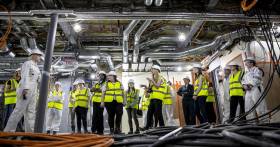Displaying items by tag: INWED
In the UK shipyard of marine engineering services company Cammell Laird based in Birkenhead, young women had a behind-the-scenes glimpse of life in engineering as part of International Women in Engineering Day (INWED) 2019.
Ten girls from schools and colleges in Birkenhead and surrounding areas met female engineers and saw shipbuilding in progress during the event organised by the shipyard and the Engineering College.
The event aimed to encourage more women into engineering and highlight the opportunities available as Cammell Laird prepares to launch a recruitment drive for apprentices.
The girls even toured polar research vessel the Sir David Attenborough, described to them by Cammell Laird chief operating officer Tony Graham as “the ship that will save the planet”. And they heard first-hand how the build is progressing from Carrie Harris, second engineer with the British Antarctic Survey, who will be one of eight women out of the ship’s 28 crew once it launches.
Mr Graham addressed the group of young women with Cammell Laird managing director Paul Owen to explain why the day was so important.
He said: “Just increasing our workforce numbers isn’t good enough for me. We need increasing levels of diversity and the right kind of talent in the business, people with passion and loyalty, who are confident and willing to learn, who are going to go on our growth journey with us.
“I’ve always considered engineering to be the only true discipline that leaves people with life defining memories and there isn’t anybody working on the Sir David Attenborough now who won’t still be talking about it in ten years’ time. We create national monuments and we need to inspire the next generation of young women to get excited about engineering.”
Mr Owen said engineering had given him the opportunity to visit 130 countries during his career. “If you are driven by challenges then engineering is a great environment to be in, but don’t wait for other people to give you these opportunities,” he said.
The day began with a visit to the neighbouring Engineering College, where Cammell Laird apprentices train, where Olivia Weston, a degree apprentice in the marketing department and a mentor for The Girls’ Network, talked about how engineering can cover all walks of life. “We’ve trained engineers who go on to fix machinery in intensive care departments, work in heavy industry or provide the audio-visual equipment in a George Ezra concert – engineering really is in everything you can think of,” she said.
The group then moved over to Cammell Laird where the girls heard from assistant ship manager Claire Biggar and former mechanical fitting apprentice Kirsten Blood, who is now a quality inspector in the tooling department.
Kirsten told the group: “The shipyard is fast-paced and ever-changing and there’s always a huge sense of achievement in everything we do. It can be a bit disheartening that there aren’t more female chief engineers or captains of ships, so we want to see more girls coming through the yard.”
Claire, a former Royal Navy weapons engineer, is currently overseeing the painting of the Sir David Attenborough.
“Ship building, and engineering, amazes me every day and it can be whatever you want it to be and take you wherever you want to go,” she said.
Carrie Harris, who led a tour of the Sir David Attenborough, will oversee the running of the vessel, which she told the group could involve everything from whether the radar was working to whether the toilets were flushing.
She said: “If you’re looking at an apprenticeship there’s a lot of job stability in engineering. It was by accident that I got into engineering but there’s nothing else I’d rather be doing.”
The International Women in Engineering Day (INWED) event aims to encourage more women into engineering careers and was backed by businesses and organisations across the industry.





























































